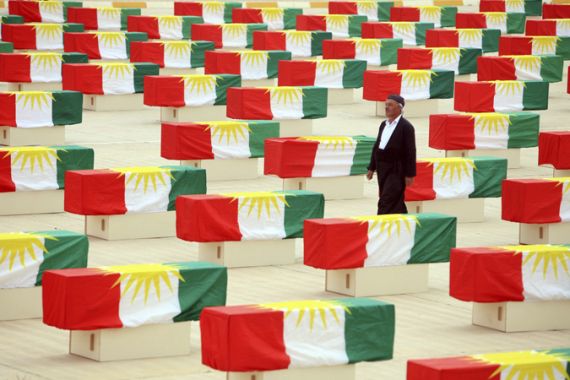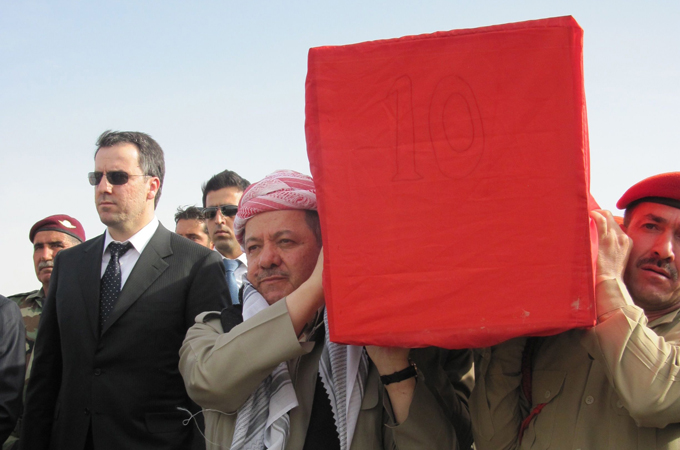Saddam’s brutality still haunts Iraqi Kurds
Relatives and friends share their grief as bodies of 730 victims of infamous Anfal campaign are reburied.

Chem Chemal, Iraq – In the framed photo Bahar Mohammad holds, her brother Salam is eternally young – smiling against a photo studio backdrop of the Kurdish region’s waterfalls, a cartoon bluebird painted in the trees.
Like tens of thousands of other young Kurdish men, his fate was to be shot and buried in the sand – to be unearthed 24 years later from a mass grave in the desert of southern Iraq and brought home.
“I feel as if he’s among these bodies,” said Bahar, as she attended a recent ceremony to rebury 730 bodies brought back from Diwaniya province. But like all the other relatives here, she can’t be certain which is his body. A surviving witness from the Qadirqaram district where most of the victims were taken says he saw Salam killed.
“The Kurdish adviser to the regime told him he should surrender and nothing would happen to him,” she says. Instead they loaded more than 90 men onto military vehicles and she never saw her younger brother again. Bahar is 57 years old now, but like almost all the survivors, the pain is as fresh as it was two decades ago.
| Bodies of Kurds killed during Saddam era found in Iraq |
Forensic experts have extracted DNA from the bones of the victims and blood samples from relatives. But matching them is a massive effort, one neither the Kurdish nor Iraqi government has the resources to do.
And the effort to exhume more of the almost 300 mass graves the Kurdish government believes exists is mired in post-war rivalries and ethnic tension.
The unearthed bodies were brought to a new monument in Chem Chemal for victims of former Iraqi dictator Saddam Hussein’s Anfal campaign during the war with Iran.
Estimates of the numbers of Iraqi Kurds killed range from 50,000 from international human rights groups, to the Kurds’ own figure of 182,000. Iraqi security forces destroyed thousands of Kurdish villages and displaced more than a million people.
At a recent ceremony in Suleymaniah, relatives of the missing filled in to sit in the hot sun. The sobs of old women in black contained decades of grief. Behind them, elegant young women in sequined abayas and the red and white sashes of the Barzani clan dabbed their eyes.
Anfal campaign
In the summer of 1983, Iraqi forces rounded up thousands of Barzanis, took them south and shot them in retribution for tribal leaders’ alignment with Iran.
The Anfal campaign that followed was named after a Koranic verse regarding the spoils of war. It also encompassed other minority groups in the north of Iraq, including Assyrian Christians, Yazidis, Shabak, and Sabaeen, but the vast majority of the victims were Kurds. Human Rights Watch estimates that 50,000 to 100,000 Kurds were murdered by Iraqi forces.
Ahmad Ali Hammed was 16 years old and in jail when his mother, two sisters and two brothers where taken away. He wanders among the rows of flag-covered coffins, wearing a long shirt on which he has written their names and ages. His youngest brother was eight years old.
“I’m the only one who survived in my family,” Hammed says. He believes the Iraqi government doesn’t want the bodies to be recovered because it will be an international reminder of what the Kurds have suffered.
|
“These crimes are committed by someone, and we believe they must be punished to discourage others.“ “ – Sabah Ahmed Mohammad, Minister in regional Kurdish government |
Another young woman, among a line of relatives held back by riot police as the coffins were being driven past, sobbed as she held a framed photo of the father she never knew. She was one year old when he was taken away.
Kurdish authorities are trying to get wider international recognition that the mass killings constituted genocide. Embroiled in a fight with federal government in Baghdad over land and resources, they are also sending the message that they will never be as powerless again.
“Today there are political factions in Iraq making every effort to maintain the impact of Arabisation, Anfal, and massacres. That is why we have to be very vigilant,” Nechervan Barzani, the Kurdish prime minister, told those attending the ceremony.
Kurdish authorities say they know of almost 300 other mass graves. Excavating them, though, requires approval from the federal government’s ministry of human rights. In addition to returning the bodies to their loved ones, they want to bring former regime officials involved in the massacres to justice.
Saddam Hussein was convicted and hung in an unrelated case before being sentenced to death for the Anfal campaign. His cousin Ali Hassan al-Majid, who supervised much of the killing, was convicted of genocide and executed.
“These crimes are committed by someone, and we believe they must be punished to discourage others,” said Sabah Ahmed Mohammad, the Minister of Martyrs and Anfal Affairs in the regional Kurdish government. “In other places in the world they found people even after 60 years and brought them to justice.”
Matching DNA samples
In addition to former regime officials, among the most controversial cases are Kurdish collaborators with Iraqi security forces whom survivors say are known but have not been arrested.
The International Commission on Missing Persons (ICMP) is working with the Iraqi and Kurdish governments on a pilot project that would identify some of the recovered bodies. But properly exhuming the graves, matching DNA samples with living relatives, and creating a co-ordination centre could take years.
 |
| Thousands of members of the Barzani clan were killed for their tribal leaders’ alignment with Iran [Jane Arraf/Al Jazeera] |
“It’s an incredibly complicated and incredibly expensive system,” says Jonathan McCaskill, Iraq director for the non-governmental organisation. He says the ICMP has taken a small number of the DNA samples from the 730 bodies recovered recently for testing in Sarejevo. “It will give Iraq a chance to evaluate whether this is something they want to do in the long term.”
The Iraqi ministry of human rights estimates that 500,000 Iraqis are buried in mass graves, from the 1980s up to the victims of Iraq’s sectarian violence just two years ago. Mass graves near Halabja, where the Saddam regime used chemical weapons against the Kurds, are still contaminated.
In the absence of witnesses, many of the families will likely never know what happened to their loved ones or where they are buried. The bodies unearthed from the Mahari desert were placed in temporary graves at Chem Chemal, each flag-draped coffin bearing a number as it was lowered into the ground.
The victims will be released to their families if DNA testing confirms any of their identities, but there are many more bodies believed to be still buried in the same location.
“The thing about Mahari, it’s a vast area and there are lots of mass graves located in that area,” said McCaskill.